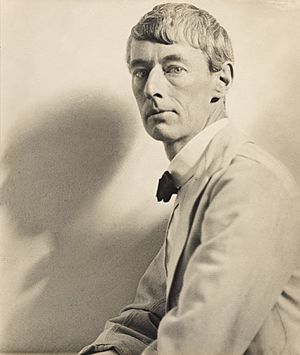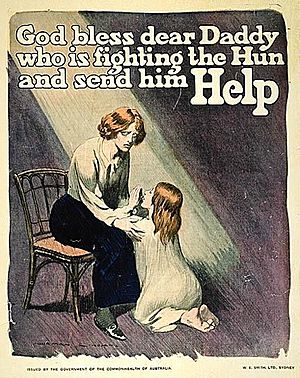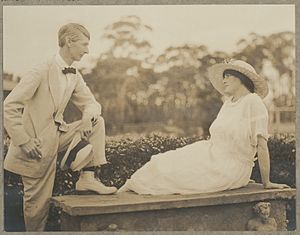Norman Lindsay facts for kids
Quick facts for kids
Norman Lindsay
|
|
|---|---|

Norman Lindsay, 1921, photographed by Harold Cazneaux
|
|
| Born |
Norman Alfred William Lindsay
22 February 1879 Creswick, Victoria, Australia
|
| Died | 21 November 1969 (aged 90) Sydney, New South Wales, Australia
|
| Nationality | Australian |
| Spouse(s) |
Kathleen Agatha Parkinson
(m. 1900; div. 1919)Rose Soady
(m. 1920) |
Norman Alfred William Lindsay (born February 22, 1879 – died November 21, 1969) was a very talented Australian artist. He was known for many things, including drawing, etching, sculpting, writing, and even cartooning. He was also an art critic and a novelist.
Norman Lindsay was one of the most active and well-known Australian artists of his time. His work was both praised and debated. Many of his artworks showed the Australian landscape mixed with ideas from ancient myths. Some people found his art controversial.
He was a strong supporter of Australian culture. He worked regularly for The Bulletin, a popular magazine, when it was very influential. He also wrote a lot about Australian art, often disagreeing with modern art styles.
When his friend, Bertram Stevens, said that children liked stories about fairies more than food, Lindsay decided to write and illustrate The Magic Pudding (1918). This book is now a famous classic in Australian children's literature.
Besides his creative work, Lindsay was known for his strong opinions and free-spirited way of life. He often disagreed with people who had very strict moral views. One of these disagreements is shown in the 1994 film Sirens. This movie starred Sam Neill and was filmed at Lindsay's home in the Blue Mountains, near Sydney. His home is now called the Norman Lindsay Gallery and Museum and is looked after by the National Trust of Australia.
Contents
About Norman Lindsay's Life
Norman Lindsay was born in Creswick, Victoria. His father, Robert Charles William Alexander Lindsay, was a surgeon. His mother, Jane Elizabeth Lindsay, was the daughter of a missionary. Norman was the fifth of ten children. Some of his siblings, like Percy Lindsay, Lionel Lindsay, Ruby Lindsay, and Daryl Lindsay, also became famous artists.
On May 23, 1900, Lindsay married Catherine (Kate) Agatha Parkinson in Melbourne. They had three sons: Jack (born 1900), Raymond (born 1903), and Philip (born 1906). They later separated.
He then married Rose Soady on January 14, 1920. Rose was also his business manager and often a model for his art. She also helped print many of his etchings. They had two daughters, Janet (born 1920) and Helen (born 1921).
Sadly, Philip passed away in 1958, and Raymond in 1960. Following in their father's footsteps, Jack became a very active writer, publisher, and translator. Philip also became a writer of historical novels and worked in the film industry.
Norman Lindsay is buried in Springwood Cemetery in Springwood. This is close to Faulconbridge, where he lived for many years.
Norman Lindsay's Career and Works

In 1895, Norman Lindsay moved to Melbourne. He worked on a local magazine with his older brother, Lionel. He wrote about his experiences in Melbourne in a book called Rooms and Houses.
In 1901, both Norman and Lionel joined the staff of The Bulletin in Sydney. This was a weekly newspaper and magazine. Norman worked there for fifty years.
Lindsay traveled to Europe in 1909, and Rose joined him later. In Naples, Italy, he started drawing 100 pen-and-ink pictures for a book called Satyricon. He also visited the Victoria and Albert Museum in London. There, he sketched model ships, which sparked a lifelong interest in building his own ship models. The Lindsays returned to Australia in 1911.
His famous children's book, The Magic Pudding, was published in 1918.
Many of his novels are lively and direct, just like his art. In 1930, his novel Redheap caused some discussion. It was thought to be based on his hometown, Creswick. Some of his books, like Redheap, explored grown-up themes and were not allowed to be sold in Australia for a while.
In 1938, Lindsay published Age of Consent. This book was about a painter who meets a young girl in the countryside who becomes his model. The book was published in Britain.

Lindsay also drew cartoons for newspapers. He often drew about political ideas that were common in The Bulletin at the time. These included concerns about communism and Asian immigration. These ideas sometimes appeared in his other works too. For example, some modern versions of The Magic Pudding remove a line that used an old-fashioned insult.
Lindsay was friends with several poets, like Kenneth Slessor and Hugh McCrae. He influenced them with his ideas about creativity, which he wrote about in his book Creative Effort. He also designed the cover for Henry Lawson's important book, While the Billy Boils. Norman's son, Jack Lindsay, moved to England. There, he started a publishing company called Fanfrolico Press, which published books with Norman's illustrations.
Norman Lindsay also influenced many other artists, especially illustrators like Roy Krenkel and Frank Frazetta. He was also good friends with Ernest Moffitt.
Norman Lindsay's Artworks
Norman Lindsay is widely considered one of Australia's greatest artists. He created a huge amount of work using different materials. These included pen drawings, etchings, watercolors, oil paintings, and sculptures made from concrete and bronze.
Lindsay had a huge amount of creative energy. People who saw him work in the 1920s described his daily routine. He would wake up early and create a watercolor painting before breakfast. By mid-morning, he would be in his etching studio, working until late afternoon. In the afternoon, he would work on a concrete sculpture in his garden. In the evening, he would write a new chapter for whatever novel he was working on.
Sometimes, for a change, he would work on a model ship. He was very inventive. He melted down the lead from oil paint tubes to make figures for his model ships. He also made a large easel from a door, carved and decorated furniture, designed and built chairs, created garden planters and Roman columns, and added his own designs to his home in Faulconbridge.
A large collection of his work is kept at his old home in Faulconbridge, New South Wales. This is now the Norman Lindsay Gallery and Museum. Many of his artworks are also owned by private collectors and companies. His art continues to be very valuable today. In 2002, his oil painting Spring's Innocence was sold to the National Gallery of Victoria for A$333,900, which was a record price at the time.
Movies and TV Shows Based on Lindsay's Work
Films
The first major movie based on Lindsay's books was the 1953 British film Our Girl Friday. This movie was based on his 1934 novel The Cautionary Armorist.
The 1969 Australian-British movie Age of Consent was based on Lindsay's 1938 novel of the same name. It was the last full-length movie directed by Michael Powell. It starred James Mason and Helen Mirren in her first credited movie role.
In 1994, Sam Neill played a made-up version of Lindsay in John Duigan's movie Sirens. This film was mostly set and filmed at Lindsay's home in Faulconbridge. The movie is also famous because it was the film debut of Australian supermodel Elle Macpherson.
Television
In 1972, five of Norman Lindsay's novels were made into TV shows. This was part of the Australian Broadcasting Corporation's Norman Lindsay festival. The novels adapted were Halfway to Anywhere, Redheap, A Curate in Bohemia, The Cousin from Fiji, and Dust or Polish.
Unfortunately, many TV programs from the late 1960s and early 1970s were erased to save money. So, it is likely that the original recordings of these Norman Lindsay TV adaptations no longer exist. Also, most people did not have video recorders at home back then, so it's unlikely that home recordings exist either.
See also
 In Spanish: Norman Lindsay para niños
In Spanish: Norman Lindsay para niños
- Kenneth G. Ross: author of the musical play Norman Lindsay and his Push in Bohemia (1978)
- Norman Lindsay Gallery and Museum
- Margaret Coen


